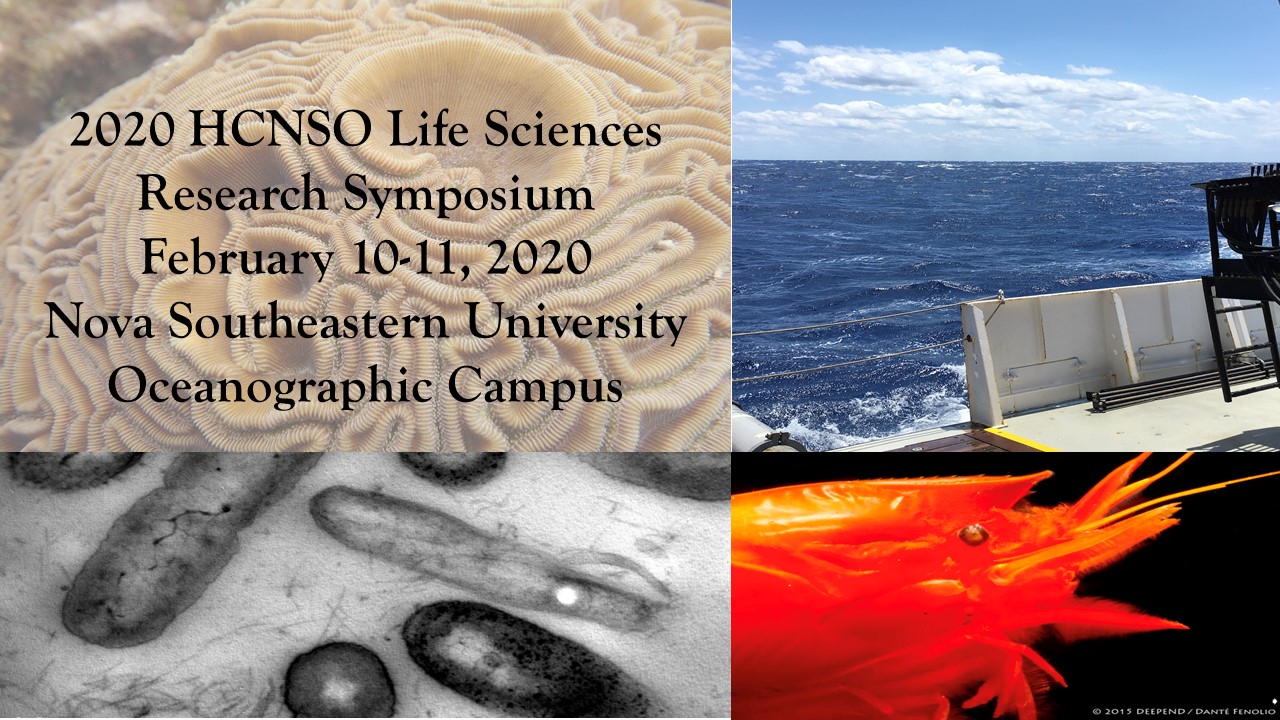Title
SE FL ECA Reef-building-coral Response to Amoxicillin Intervention and Broader-scale Coral Disease Intervention
Location
HCNSO Guy Harvey Oceanographic Center Nova Southeastern University
Start
2-10-2020 11:15 AM
End
2-10-2020 11:30 AM
Type of Presentation
Oral Presentation
Abstract
SE FL ECA Reef-building-coral Response to Amoxicillin Intervention and Broader-scale Coral Disease Intervention.
Hunter Noren, Samantha Buckley, Kelly Pitts, Brian Walker
Abstract
Florida’s Coral Reef (FCR) is a large barrier reef system in Southern Florida comprised of the Dry Tortugas, Florida Keys, and Southeast Florida Coral Reef Ecosystem Conservation Area (Coral ECA). Since 2014 the Stony Coral Tissue Loss Disease (SCTLD) has ravaged the FCR and has recently spread to other Caribbean countries. SCTLD has persisted the longest in the Coral ECA. The causal agent of the disease is unknown, yet its response to antibiotic treatments in the Florida Keys infers it has a bacterial component. Once infected, colony death is imminent without intervention. Initial interventions using chlorinated epoxy had low success (<40%) on Montastraea cavernosa (Mcav), the most prevalent regional diseased coral. The Coral ECA reefs are exposed to millions of liters of treated water containing high amounts of antibiotics from local sewage outfalls, therefore it was unknown if antibiotic treatments would be effective. Hence, this study compared the success of antibiotic paste versus chlorinated epoxy on diseased Mcav colonies at three in-situ experimental sites located in Miami-Dade County. Treatments consisted of cutting a “firebreak” approximately 5 cm from the active disease margin. Then filling the firebreak and smothering the disease margin with the treatment material. The antibiotic paste treatments on disease margins and firebreaks had a 94.4% treatment success versus 30.6% success with chlorinated epoxy. Without a firebreak treatment success decreased to 78.9% for the antibiotic paste and 10.5% for chlorinated epoxy. These results support that the SCTLD lesions and tissue loss are likely a bacterial process and the presence of antibiotics in the water column from nearby sewage outfalls has not elicited antibiotic resistance to amoxicillin in the corals. There was no observed long-term benefit from the antibiotic treatment as the lesion-level treatments do not appear to deter subsequent disease infections, which varied over time and individuals. Firebreak healing was observed in 90.5% of Mcav treated with antibiotic paste versus only 15% among corals treated with chlorinated epoxy. Broader scale efforts continue throughout Broward and Miami-Dade. As of November 2019, over 440 corals totaling 251 m of treatment margin on six coral species were treated.
SE FL ECA Reef-building-coral Response to Amoxicillin Intervention and Broader-scale Coral Disease Intervention
HCNSO Guy Harvey Oceanographic Center Nova Southeastern University
SE FL ECA Reef-building-coral Response to Amoxicillin Intervention and Broader-scale Coral Disease Intervention.
Hunter Noren, Samantha Buckley, Kelly Pitts, Brian Walker
Abstract
Florida’s Coral Reef (FCR) is a large barrier reef system in Southern Florida comprised of the Dry Tortugas, Florida Keys, and Southeast Florida Coral Reef Ecosystem Conservation Area (Coral ECA). Since 2014 the Stony Coral Tissue Loss Disease (SCTLD) has ravaged the FCR and has recently spread to other Caribbean countries. SCTLD has persisted the longest in the Coral ECA. The causal agent of the disease is unknown, yet its response to antibiotic treatments in the Florida Keys infers it has a bacterial component. Once infected, colony death is imminent without intervention. Initial interventions using chlorinated epoxy had low success (<40%) on Montastraea cavernosa (Mcav), the most prevalent regional diseased coral. The Coral ECA reefs are exposed to millions of liters of treated water containing high amounts of antibiotics from local sewage outfalls, therefore it was unknown if antibiotic treatments would be effective. Hence, this study compared the success of antibiotic paste versus chlorinated epoxy on diseased Mcav colonies at three in-situ experimental sites located in Miami-Dade County. Treatments consisted of cutting a “firebreak” approximately 5 cm from the active disease margin. Then filling the firebreak and smothering the disease margin with the treatment material. The antibiotic paste treatments on disease margins and firebreaks had a 94.4% treatment success versus 30.6% success with chlorinated epoxy. Without a firebreak treatment success decreased to 78.9% for the antibiotic paste and 10.5% for chlorinated epoxy. These results support that the SCTLD lesions and tissue loss are likely a bacterial process and the presence of antibiotics in the water column from nearby sewage outfalls has not elicited antibiotic resistance to amoxicillin in the corals. There was no observed long-term benefit from the antibiotic treatment as the lesion-level treatments do not appear to deter subsequent disease infections, which varied over time and individuals. Firebreak healing was observed in 90.5% of Mcav treated with antibiotic paste versus only 15% among corals treated with chlorinated epoxy. Broader scale efforts continue throughout Broward and Miami-Dade. As of November 2019, over 440 corals totaling 251 m of treatment margin on six coral species were treated.


